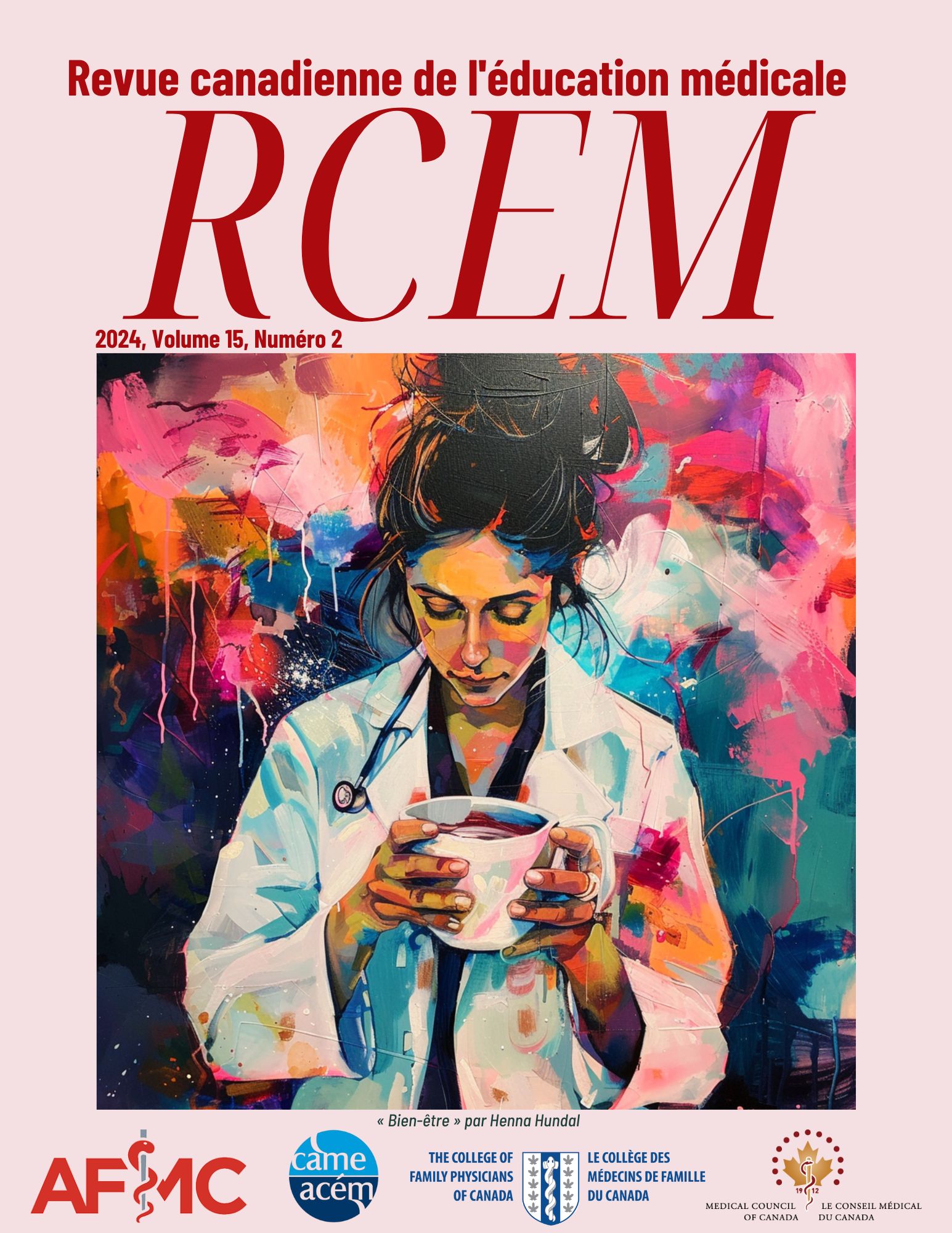Association entre le sexe et l'identité raciale ou ethnique et la réussite au processus d'admission dans une faculté de médecine canadienne : étude de cohorte prospective
DOI :
https://doi.org/10.36834/cmej.75255Résumé
Contexte : Des données canadiennes portent à croire que les candidats noirs peuvent avoir moins de succès que d'autres groupes lorsqu'ils postulent à une faculté de médecine. Nous avons cherché à décrire de manière exhaustive l'identité raciale et/ou ethnique, l'identité de genre, l'orientation sexuelle et les capacités des candidats à une seule faculté de médecine canadienne. Nous avons également cherché à établir un lien entre la réussite à chaque étape de la candidature et le sexe et l'identité raciale du candidat ou de la candidate.
Méthodes : Les candidats de la promotion 2024 à une faculté de médecine canadienne ont été invités à répondre à une enquête démographique. Les chances d'atteindre chaque étape de la candidature (entrevue offerte, place offerte et inscription) ont été déterminées pour chaque groupe démographique.
Résultats : Il y a eu 595 participants (taux de réponse de 32,4 %). Les caractéristiques démographiques des candidats à l’admission et des étudiants admis étaient similaires. Il n'y avait pas de différence entre les candidats blancs et les candidats autochtones, noirs et de couleur (PANDC) en ce qui concerne les offres d'entrevue ou les admissions. Les hommes cisgenres étaient surreprésentés dans les entrevues par rapport aux femmes cisgenres (OR 0,64; 95%CI 0,43-0,95 ; p=0,03) mais pas dans les admissions. Les femmes cisgenres appartenant au groupe des PANDC ont reçu plus d'offres d’entrevue que les autres groupes (OR 2,74, 95%CI 1,20-6,25 ; p=0,02).
Conclusions : Les différences les plus marquées dans la réussite des candidats à l’admission parmi les différents groupes démographiques étaient quant aux offres d’entrevue.
Téléchargements
Références
Ruzycki SM, Roach P, Ahmed SB, Barnabe C, Holroyd-Leduc J. Diversity of physicians in leadership and academic positions in Alberta: a cross-sectional survey. BMJ Leader. 2022;January 2022. https://doi.org/10.1136/leader-2021-000554
Dhalla IA, Kwong JC, Streiner DL, Baddour RE, Waddell AE, Johnson IL. Characteristics of first-year students in Canadian medical schools. CMAJ. 2002;166(8):1029-35.
Lucey C, Saguil A. The consequences of structural racism on MCAT scores and medical school admissions: the past is prologue. Acad Med. 2020;95(3):351-6. https://doi.org/10.1097/ACM.0000000000002939 DOI: https://doi.org/10.1097/ACM.0000000000002939
UME UoT. Black student application program 2022. Available from: https://applymd.utoronto.ca/black-student-application-program. [Accessed Mar 24, 2022]
Medicine CSo. Pathways to Medicine Scholarship Program 2021 Available from: https://cumming.ucalgary.ca/future-students/scholarships/pathways-medicine-scholarship. [Accessed Mar 24, 2022]
Leduc JM, Kpadé V, Bizimungu S, et al. Black students applying and admitted to medicine in the province of Quebec, Canada: what do we know so far? Can Med Ed J. 2022;12(6):78-81. https://doi.org/10.36834/cmej.72017 DOI: https://doi.org/10.36834/cmej.72017
Canada TAoFoMo. 2020 Canadian Medical Education Statistics. Ottawa, Ontario; 2021.
Constitution Act, 1982: Part 1 Canadian Charter of Rights and Freedoms Government of Canada 1982. updated Sept 28, 2022. Available from: https://laws-lois.justice.gc.ca/eng/Const/page-12.html.
Ruzycki SM, Roach P, Ahmed S, Barnabe C, Holroyd-Leduc J. Diversity of physicians in leadership and academic positions in Alberta: a cross-sectional survey. BMJ Leader. 2022. https://doi.org/10.1136/leader-2021-000554 DOI: https://doi.org/10.1136/leader-2021-000554
Evans-Winters VE, Esposito J. Other people's daughters: critical race feminism and Black girls' education. Educ Found. 2010;Winter-Spring:11-25.
Bailey M. Misogynoir in medical media: on Caster Semenya and R Kelly. Catalyst. 2016;2(2):1-31. https://doi.org/10.28968/cftt.v2i2.28800 DOI: https://doi.org/10.28968/cftt.v2i2.28800
von Elm E, Altman DG, Egger M, et al. The Strengthening the Reporting of Observational Studies in Epidemiology (STROBE) statement: guidelines for reporting observational studies. Rev Esp Salud Publica. 2008;82(3):251-9. https://doi.org/10.1016/j.jclinepi.2007.11.008 DOI: https://doi.org/10.1590/S1135-57272008000300002
RSC 1985 (1985).
Jones CP. Levels of racism: a theoretical framework and a gardener's tale. Amer J Pub Health. 2000;90:1212-5. https://doi.org/10.2105/AJPH.90.8.1212 DOI: https://doi.org/10.2105/AJPH.90.8.1212
Nixon SA. The coin model of privilege and critical allyship: implications for health. BMC Pub Health. 2019;19(1):1637. https://doi.org/10.1186/s12889-019-7884-9 DOI: https://doi.org/10.1186/s12889-019-7884-9
Crenshaw K. Mapping the margins: intersectionality, identity politics, and violence against women of color. Stanford Law Rev. 1991;43(6):1241-300. https://doi.org/10.2307/1229039 DOI: https://doi.org/10.2307/1229039
Halbesleben JR, Whitman MV. Evaluating survey quality in health services research: a decision framework for assessing nonresponse bias. Health Serv Res. 2013;48(3):913-30. https://doi.org/10.1111/1475-6773.12002 DOI: https://doi.org/10.1111/1475-6773.12002
Collier R. Medical school admission targets urged for rural and low- income Canadians. Can Med Assoc J. 2010;182(8):E327-E8. https://doi.org/10.1503/cmaj.109-3227 DOI: https://doi.org/10.1503/cmaj.109-3227
Téléchargements
Publié-e
Comment citer
Numéro
Rubrique
Licence
© Rabiya Jalil, Makela Nkemdirim, Pamela Roach, Remo Panaccione, Shannon M Ruzycki 2023

Cette œuvre est sous licence Creative Commons Attribution - Pas d'Utilisation Commerciale - Pas de Modification 4.0 International.
La soumission d’un manuscrit original à la revue constitue une indication qu’il s’agit d’un travail original, qu’il n’a jamais été publié et qu’il n’est pas envisagé pour publication dans une autre revue. S’il est accepté, il sera publié en ligne et ne pourra l’être ailleurs sous la même forme, à des fins commerciales, dans quelque langue que ce soit, sans l’accord de l’éditeur.
La publication d’une recherche scientifique a pour but la diffusion de connaissances et, sous un régime sans but lucratif, ne profite financièrement ni à l’éditeur ni à l’auteur.
Les auteurs qui publient dans la Revue canadienne d’éducation médicale acceptent de publier leurs articles sous la licence Creative Commons Paternité - Pas d’utilisation commerciale, Pas de modification 4.0 Canada. Cette licence permet à quiconque de télécharger et de partager l’article à des fins non commerciales, à condition d’en attribuer le crédit aux auteurs. Pour plus de détails sur les droits que les auteurs accordent aux utilisateurs de leur travail, veuillez consulter le résumé de la licence et la licence complète.










